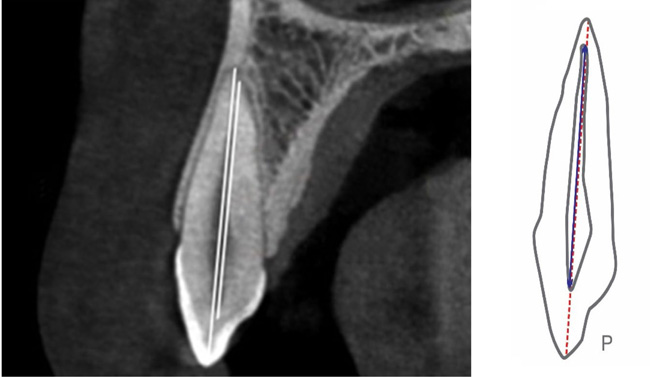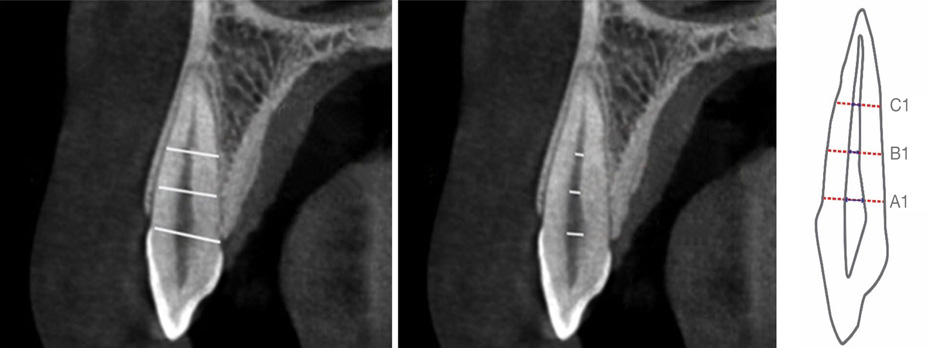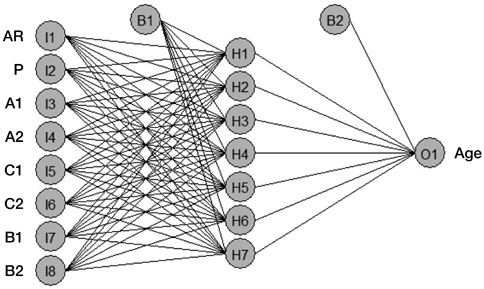Imaging Sci Dent.
2019 Mar;49(1):19-26. 10.5624/isd.2019.49.1.19.
Dental age estimation using the pulp-to-tooth ratio in canines by neural networks
- Affiliations
-
- 1Department of Biostatistics, School of Public Health and Research Center for Health Sciences, Hamadan University of Medical Sciences, Hamadan, Iran.
- 2Department of Oral and Maxillofacial Radiology, Dental School, Hamadan University of Medical Sciences, Hamadan, Iran. dr.salemi@yahoo.com
- KMID: 2442105
- DOI: http://doi.org/10.5624/isd.2019.49.1.19
Abstract
- PURPOSE
It has been proposed that using new prediction methods, such as neural networks based on dental data, could improve age estimation. This study aimed to assess the possibility of exploiting neural networks for estimating age by means of the pulp-to-tooth ratio in canines as a non-destructive, non-expensive, and accurate method. In addition, the predictive performance of neural networks was compared with that of a linear regression model.
MATERIALS AND METHODS
Three hundred subjects whose age ranged from 14 to 60 years and were well distributed among various age groups were included in the study. Two statistical software programs, SPSS 21 (IBM Corp., Armonk, NY, USA) and R, were used for statistical analyses.
RESULTS
The results indicated that the neural network model generally performed better than the regression model for estimation of age with pulp-to-tooth ratio data. The prediction errors of the developed neural network model were acceptable, with a root mean square error (RMSE) of 4.40 years and a mean absolute error (MAE) of 4.12 years for the unseen dataset. The prediction errors of the regression model were higher than those of the neural network, with an RMSE of 10.26 years and a MAE of 8.17 years for the test dataset.
CONCLUSION
The neural network method showed relatively acceptable performance, with an MAE of 4.12 years. The application of neural networks creates new opportunities to obtain more accurate estimations of age in forensic research.
MeSH Terms
Figure
Reference
-
1. Cameriere R, Cunha E, Sassaroli E, Nuzzolese E, Ferrante L. Age estimation by pulp/tooth area ratio in canines: study of a Portuguese sample to test Cameriere's method. Forensic Sci Int. 2009; 193:128.e1–128.e6.
Article2. Rai A, Acharya AB, Naikmasur VG. Age estimation by pulp-to-tooth area ratio using cone-beam computed tomography: a preliminary analysis. J Forensic Dent Sci. 2016; 8:150–154.
Article3. Bolanos MV, Manrique MC, Bolanos MJ, Briones MT. Approaches to chronological age assessment based on dental calcification. Forensic Sci Int. 2000; 110:97–106.4. Cameriere R, Ferrante L, Cingolani M. Precision and reliability of pulp/tooth area ratio (RA) of second molar as indicator of adult age. J Forensic Sci. 2004; 49:1319–1323.
Article5. Biuki N, Razi T, Faramarzi M. Relationship between pulp-tooth volume ratios and chronological age in different anterior teeth on CBCT. J Clin Exp Dent. 2017; 9:e688–e693.
Article6. Jagannathan N, Neelakantan P, Thiruvengadam C, Ramani P, Premkumar P, Natesan A, et al. Age estimation in an Indian population using pulp/tooth volume ratio of mandibular canines obtained from cone beam computed tomography. J Forensic Odontostomatol. 2011; 29:1–6.7. Babshet M, Acharya AB, Naikmasur VG. Age estimation in Indians from pulp/tooth area ratio of mandibular canines. Forensic Sci Int. 2010; 197:125.e1–125.e4.
Article8. Cameriere R, Ferrante L, Belcastro MG, Bonfiglioli B, Rastelli E, Cingolani M. Age estimation by pulp/tooth ratio in canines by peri-apical X-rays. J Forensic Sci. 2007; 52:166–170.
Article9. Kvaal SI, Kolltveit KM, Thomsen IO, Solheim T. Age estimation of adults from dental radiographs. Forensic Sci Int. 1995; 74:175–185.
Article10. Cameriere R, Ferrante L, Cingolani M. Variations in pulp/tooth area ratio as an indicator of age: a preliminary study. J Forensic Sci. 2004; 49:317–319.
Article11. Juneja M, Devi YB, Rakesh N, Juneja S. Age estimation using pulp/tooth area ratio in maxillary canines - a digital image analysis. J Forensic Dent Sci. 2014; 6:160–165.12. Graham JP, O'Donnell CJ, Craig PJ, Walker GL, Hill AJ, Cirillo GN, et al. The application of computerized tomography (CT) to the dental ageing of children and adolescents. Forensic Sci Int. 2010; 195:58–62.
Article13. Maret D, Molinier F, Braga J, Peters OA, Telmon N, Treil J, et al. Accuracy of 3D reconstructions based on cone beam computed tomography. J Dent Res. 2010; 89:1465–1469.
Article14. Hastie T, Tibshirani R, Friedman J. The elements of statistical learning: data mining, inference and prediction. Springer series in statistics. 2rd ed. New York, NY: Springer;2009.15. Lisboa PJ. A review of evidence of health benefit from artificial neural networks in medical intervention. Neural Netw. 2002; 15:11–39.
Article16. Farhadian M, Aliabadi M, Darvishi E. Empirical estimation of the grades of hearing impairment among industrial workers based on new artificial neural networks and classical regression methods. Indian J Occup Environ Med. 2015; 19:84–89.
Article17. Devito KL, de Souza Barbosa F, Felippe Filho WN. An artificial multilayer perceptron neural network for diagnosis of proximal dental caries. Oral Surg Oral Med Oral Pathol Oral Radiol Endod. 2008; 106:879–884.
Article18. Moghimi S, Talebi M, Parisay I. Design and implementation of a hybrid genetic algorithm and artificial neural network system for predicting the sizes of unerupted canines and premolars. Eur J Orthod. 2012; 34:480–486.
Article19. Eskandarloo A, Mirshekari A, Poorolajal J, Mohammadi Z, Shokri A. Comparison of cone-beam computed tomography with intraoral photostimulable phosphor imaging plate for diagnosis of endodontic complications: a simulation study. Oral Surg Oral Med Oral Pathol Oral Radiol. 2012; 114:e54–e61.
Article20. Singaraju S, Sharda P. Age estimation using pulp-tooth area ratio: a digital image analysis. J Forensic Dent Sci. 2009; 1:37–41.
Article21. De Angelis D, Gaudio D, Guercini N, Cipriani F, Gibelli D, Caputi S, et al. Age estimation from canine volumes. Radiol Med. 2015; 120:731–736.
Article22. Bagherpour A, Anbiaee N, Partovi P, Golestani S, Afzalinasab S. Dental age assessment of young Iranian adults using third molars: a multivariate regression study. J Forensic Leg Med. 2012; 19:407–412.
Article23. Babyak MA. What you see may not be what you get: a brief, nontechnical introduction to overfitting in regression-type models. Psychosom Med. 2004; 66:411–421.
Article24. Marroquin TY, Karkhanis S, Kvaal SI, Vasudavan S, Kruger E, Tennant M. Age estimation in adults by dental imaging assessment systematic review. Forensic Sci Int. 2017; 275:203–211.
Article
- Full Text Links
- Actions
-
Cited
- CITED
-
- Close
- Share
- Similar articles
-
- Determining the age of cats by pulp cavity/tooth width ratio using dental radiography
- Age Estimation Using Attrition and Pulp Cavity Size of the Mandibular First Molar in Korean Population
- Dental Radiography for Age Estimation: A Scoping Review
- Dental age estimation in Indonesian adults: An investigation of the maxillary canine pulp-to-tooth volume ratio using cone-beam computed tomography
- Artificial neural network model for predicting sex using dental and orthodontic measurements






